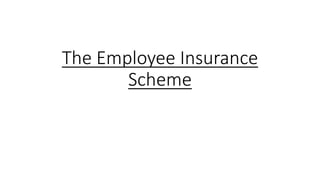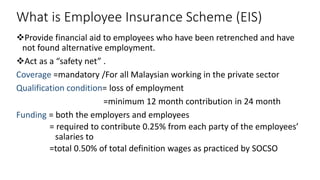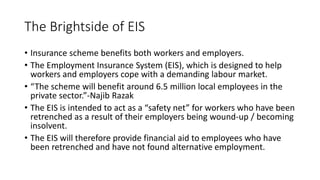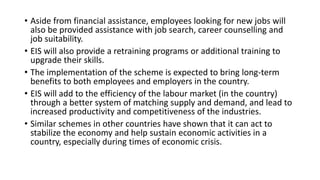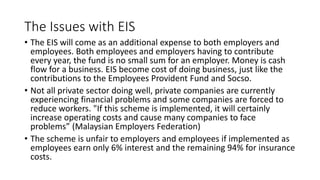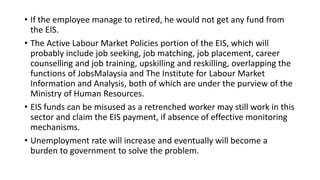Malaysia Employee Insurance Scheme
- 2. What is Employee Insurance Scheme (EIS) ’üČProvide financial aid to employees who have been retrenched and have not found alternative employment. ’üČAct as a ŌĆ£safety netŌĆØ . Coverage =mandatory /For all Malaysian working in the private sector Qualification condition= loss of employment =minimum 12 month contribution in 24 month Funding = both the employers and employees = required to contribute 0.25% from each party of the employeesŌĆÖ salaries to =total 0.50% of total definition wages as practiced by SOCSO
- 3. Benefit structure = paid half of their last salary until they find a job or for up to six months =job matching/placement services and career counselling =retrained and reskilled people Administrative = managed by Social Security Organization (Socso) =supervised by Ministry of Human Resource ’üČTargets to prevent unemployment and diversify risks during labor market transition. ’üČSome countries in Asia that have employment insurance schemes also feature government contributions to these schemes (Thailand ŌĆō 0.25%, Taiwan ŌĆō 0.1%, Vietnam ŌĆō 1%).
- 4. When? ’üČPlanning papers for the scheme have already been approved by the Economic Planning Unit. ’üČTabled at the parliamentary sitting in June 2017 ’üČExpected to be enforced from 1 January 2018
- 5. The Brightside of EIS ŌĆó Insurance scheme benefits both workers and employers. ŌĆó The Employment Insurance System (EIS), which is designed to help workers and employers cope with a demanding labour market. ŌĆó ŌĆ£The scheme will benefit around 6.5 million local employees in the private sector.ŌĆØ-Najib Razak ŌĆó The EIS is intended to act as a ŌĆ£safety netŌĆØ for workers who have been retrenched as a result of their employers being wound-up / becoming insolvent. ŌĆó The EIS will therefore provide financial aid to employees who have been retrenched and have not found alternative employment.
- 6. ŌĆó Aside from financial assistance, employees looking for new jobs will also be provided assistance with job search, career counselling and job suitability. ŌĆó EIS will also provide a retraining programs or additional training to upgrade their skills. ŌĆó The implementation of the scheme is expected to bring long-term benefits to both employees and employers in the country. ŌĆó EIS will add to the efficiency of the labour market (in the country) through a better system of matching supply and demand, and lead to increased productivity and competitiveness of the industries. ŌĆó Similar schemes in other countries have shown that it can act to stabilize the economy and help sustain economic activities in a country, especially during times of economic crisis.
- 7. The Issues with EIS ŌĆó The EIS will come as an additional expense to both employers and employees. Both employees and employers having to contribute every year, the fund is no small sum for an employer. Money is cash flow for a business. EIS become cost of doing business, just like the contributions to the Employees Provident Fund and Socso. ŌĆó Not all private sector doing well, private companies are currently experiencing financial problems and some companies are forced to reduce workers. "If this scheme is implemented, it will certainly increase operating costs and cause many companies to face problemsŌĆØ (Malaysian Employers Federation) ŌĆó The scheme is unfair to employers and employees if implemented as employees earn only 6% interest and the remaining 94% for insurance costs.
- 8. ŌĆó If the employee manage to retired, he would not get any fund from the EIS. ŌĆó The Active Labour Market Policies portion of the EIS, which will probably include job seeking, job matching, job placement, career counselling and job training, upskilling and reskilling, overlapping the functions of JobsMalaysia and The Institute for Labour Market Information and Analysis, both of which are under the purview of the Ministry of Human Resources. ŌĆó EIS funds can be misused as a retrenched worker may still work in this sector and claim the EIS payment, if absence of effective monitoring mechanisms. ŌĆó Unemployment rate will increase and eventually will become a burden to government to solve the problem.

